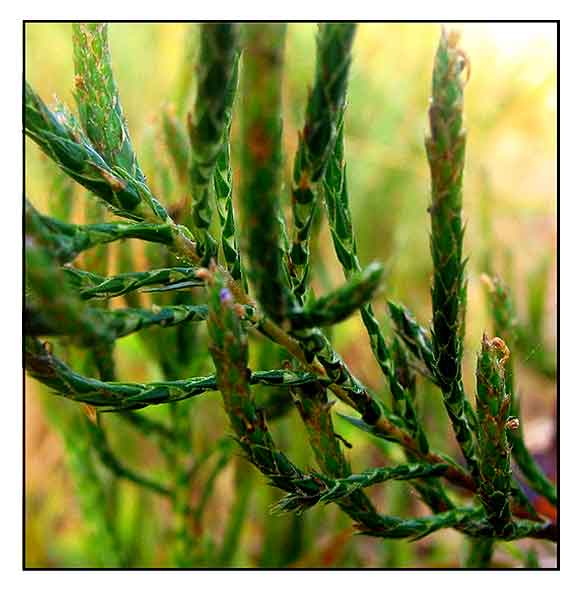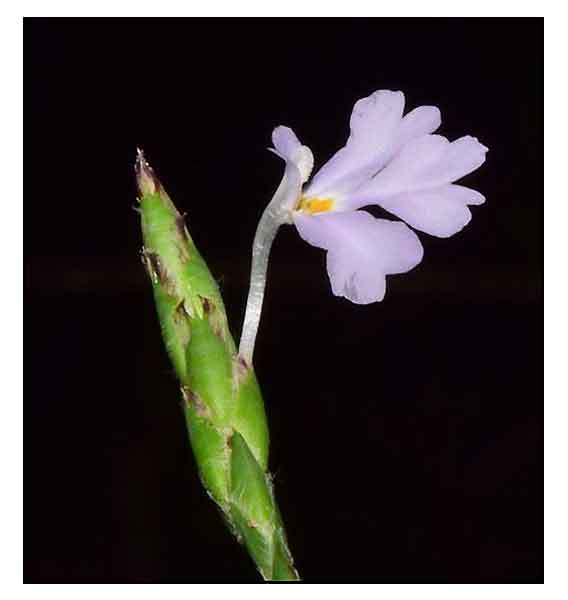 Gen info Gen info
- Elytraria is a genus of flowering plants in the family Acanthaceae, with a pantropical distribution. They tend to lack stems.
- Etymology: The genus name Elytraria derives from Greek elytron referring to the scaly envelopes or sheaths of stem and flower scapes. The species epithet imbricata means "overlapping" or "closely put together" referring to the calyx lobes.
(3)
- The English name Purple scalystem derives from its rough scale-like stalk, contrasting beautifully with the plant's almost iridescent purple flowers.
Botany
General: Acaulescent or leaves crowded at tip of a glabrous or sparingly pilose stem to 30 cm long. Leaves: Blades ovate to oblong or obovate, rarely linear–lanceolate, usually 3–12 cm long, 1.5–4 cm wide, blunt or acute at apex, narrowed at base to a slender winged petiole, both surfaces appressed–pilose or glabrate, margins undulate. Flowers: Numerous scapes, axillary, usually 5–24 cm long, simple or branched, covered by tightly appressed, ovate to subulate scales; spikes 1 to several to 6 cm long, bracts oblong to elliptic, 3–6 mm long, 1–2 mm wide, firm, awn–tipped and bearing near apex a pair of triangular or rhombic hyaline teeth; bractlets 3 mm long, calyx segments thin, upper bidentate; corolla narrowly funnelform blue, 5–8 mm long. Fruits: Glabrous capsule. (3)
 Caulescent perennial herb to 50 cm; stem subterete to sharply 3-angulate, sparsely pubescent; leaves clustered at stem apices, subsessile to petiolate; blades elliptic to obovate, 2.5-13.5 x 1-4.5 cm, pubescent, margin entire to crenate; inflorescence of scapose or pedunculate densely bracteate terminal dichasiate spikes, the spikes slender, cylindric, scapes or peduncules covered with imbricate coriaceous clasping scales; bracts alternate, green with hyaline margin, ovate to elliptic, 3-6 x 1.5-3 mm, 3-dentate apically, glabrous; bracteoles 2, subulate; calyx deeply 4- lobed, mostly hyaline, lobes heteromorphic; corolla blue and white, 3.5-7.5 mm long, glabrous, tube cylindric, limb bilabiate, lower lip 3-lobed, lobes apically cleft, upper lip 2-lobed; stamens 2; anthers 2-thecous, the thecae lacking basal appendages; capsule estipitate, subconic to ovoid; seeds 12-16. Extremely variable in its habit form, ranging from small plantainlike herbs of a few centimeters to subligneous-stemmed plants 50 cm high. (7) Caulescent perennial herb to 50 cm; stem subterete to sharply 3-angulate, sparsely pubescent; leaves clustered at stem apices, subsessile to petiolate; blades elliptic to obovate, 2.5-13.5 x 1-4.5 cm, pubescent, margin entire to crenate; inflorescence of scapose or pedunculate densely bracteate terminal dichasiate spikes, the spikes slender, cylindric, scapes or peduncules covered with imbricate coriaceous clasping scales; bracts alternate, green with hyaline margin, ovate to elliptic, 3-6 x 1.5-3 mm, 3-dentate apically, glabrous; bracteoles 2, subulate; calyx deeply 4- lobed, mostly hyaline, lobes heteromorphic; corolla blue and white, 3.5-7.5 mm long, glabrous, tube cylindric, limb bilabiate, lower lip 3-lobed, lobes apically cleft, upper lip 2-lobed; stamens 2; anthers 2-thecous, the thecae lacking basal appendages; capsule estipitate, subconic to ovoid; seeds 12-16. Extremely variable in its habit form, ranging from small plantainlike herbs of a few centimeters to subligneous-stemmed plants 50 cm high. (7)
Distribution
- Introduced to the Philippines.
- Invasive. In open waste places, dry thickets, in and about towns at low altitudes.
- Also introduced to Galapagos, Madagascar, Vietnam.
- Native range is S. USA to NW Argentina.
- Grows primarily in the seasonally dry tropical biome.
(1)
Constituents
- No phytochemical studies found.
Properties
- Studies have shown neuroprotective, antimycobacterial properties.
 Parts used Parts used
Leaves, shoots, flowers.
Uses
Edibility
- In Mexico, the Mountain Pima prepare tea from shoots of the plant.
Folkloric
- No reported folkloric use in the Philippines.
- Plant use for treatment of dysentery. Infusion used for treatment of bronchits and coughs. Crushed leaves used for treatment of pimples.
(2)
- In Mayan medicine, used to hasten childbirth: Thirteen plants boiled with 15 centimeters of pixoy (Guazuma ulmifolia) bark in one-half liter of water; drink warm, and baby will be born in one-half hour. Also used as remedy for dysentery, hematemesis (vomiting of blood) and liver complaints. (8)
- In Baja, Mexico, decoction of shoots used for treatment of fever, various urinary tract infections. In El Salvador, used for treatment of dysentery.
(9)
- In Curacao, used for stomachaches.
- Decoction of leaves and flowers drunk for fever. Tea from whole plant used for diarrhea. Mayans believe mixing it with Carlowrightia arizonica has a synergistic effect. Tea brewed with an unidentified plant called "ortiga" is drunk for malaria. (10)
Studies
• Neuroprotective / Glutamate-Induced Toxicity: Study evaluated the potential in-vitro neuroprotective property of plants used in Mayan traditional medicine tested on models in which neuronal damage was induced by glutamate, i.e., a human neuroblastoma cell line (SH-SY5Y) and rat cortical neurons. Of 34 plants studied in the analysis, three extracts exhibited neuroprotective effect in the rat neuron cortical model, with the most active being extract from Elytraria imbricata aerial parts with EC50 of 6.8 ± 3.1 µg/mL). (4)
• Antimycobacterial: Study of ethanol extract in antimycobaterial test against Mycobacterium tuberculosis showed 24% inhibition at 100 µg/ml. (6)
Availability
Wild-crafted.
|







